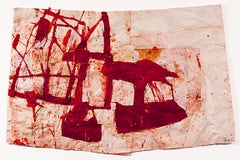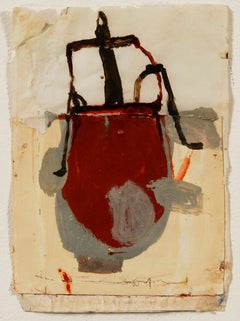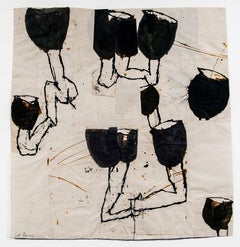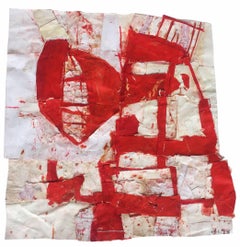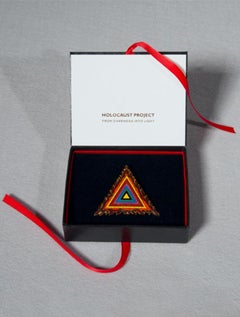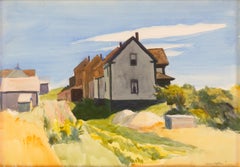Sati Zech Art
13
9
3
2
1
2
7
Overall Height
to
Overall Width
to
1
13
13
6,958
3,331
2,514
1,213
10
6
6
6
6
Artist: Sati Zech
Untitled
By Sati Zech
Located in Lincoln, MA
mixed media, oil, plaster, glue on canvas
Category
2010s Sati Zech Art
Pot 5
By Sati Zech
Located in Lincoln, MA
mixed media on paper
Category
2010s Sati Zech Art
Pot 1
By Sati Zech
Located in Lincoln, MA
mixed media on paper
Category
2010s Sati Zech Art
Materials
Mixed Media
Untitled
By Sati Zech
Located in Lincoln, MA
mixed media, oil, glue on paper
Category
2010s Sati Zech Art
Materials
Mixed Media
Bollenarbeit Nr. 443
By Sati Zech
Located in Lincoln, MA
mixed media, oil, thread, glue, cotton, plaster
Category
2010s Sati Zech Art
Materials
Mixed Media
Lamp
By Sati Zech
Located in Lincoln, MA
Mixed Media, Cotton, Plaster, Oil, Glue on Paper
Category
2010s Sati Zech Art
Bollenarbeit No. 107
By Sati Zech
Located in Lincoln, MA
mixed media, plaster, cotton, oil, glue
Category
2010s Sati Zech Art
Materials
Cotton, Plaster, Paint, Glue, Mixed Media
Bollenarbeit NR 267
By Sati Zech
Located in Lincoln, MA
mixed media, cotton , plaster, oil, glue
Category
2010s Sati Zech Art
Materials
Cotton, Plaster, Paint, Glue, Mixed Media
Hanging Bridge
By Sati Zech
Located in Lincoln, MA
mixed media on paper
Category
2010s Sati Zech Art
Materials
Paper, Mixed Media
Pollenarbeit NR 274
By Sati Zech
Located in Lincoln, MA
mixed media, cotton, plaster, oil, glue
Category
2010s Sati Zech Art
Materials
Cotton, Plaster, Paint, Glue, Mixed Media
Bollenarbeit NR 270
By Sati Zech
Located in Lincoln, MA
mixed media, cotton, plaster, oil, glue
Category
2010s Sati Zech Art
Materials
Cotton, Plaster, Paint, Glue, Mixed Media
Pollenarbeit NR 286
By Sati Zech
Located in Lincoln, MA
mixed media, cotton, plaster, oil, glue
Category
2010s Sati Zech Art
Materials
Cotton, Plaster, Paint, Glue, Mixed Media
Pollenarbeit NR 264
By Sati Zech
Located in Lincoln, MA
mixed media, cotton, plaster, oil, glue
Category
2010s Sati Zech Art
Materials
Cotton, Plaster, Paint, Glue, Mixed Media
Related Items
Holocaust Remembrance Logo Pin and Pendant
By Judy Chicago
Located in New York, NY
Judy Chicago
Logo Pin and Pendant, 1993
Enameled pin with pendant loop in original presentation box
2 1/2 × 2 1/2 × 1/5 inches
Judy Chicago's incised name and date on the verso
Comes in original presentation gift box
Poignant enameled Holocaust Project Logo pin & pendant based on the logo designed by Judy Chicago for the Holocaust Project: From Darkness into Light
More about pioneering artist Judy Chicago
Judy Chicago (born Judith Sylvia Cohen; July 20, 1939) is an American feminist artist, art educator, and writer known for her large collaborative art installation pieces about birth and creation images, which examine the role of women in history and culture. During the 1970s, Chicago founded the first feminist art program in the United States at California State University, Fresno (formerly Fresno State College) which acted as a catalyst for feminist art and art education during the 1970s. Her inclusion in hundreds of publications in various areas of the world showcases her influence in the worldwide art community. Additionally, many of her books have been published in other countries, making her work more accessible to international readers. Chicago's work incorporates a variety of artistic skills, such as needlework, counterbalanced with skills such as welding and pyrotechnics. Chicago's most well known work is The Dinner Party, which is permanently installed in the Elizabeth A. Sackler Center for Feminist Art at the Brooklyn Museum. The Dinner Party celebrates the accomplishments of women throughout history and is widely regarded as the first epic feminist artwork. Other notable art projects by Chicago include International Honor Quilt, Birth Project, Powerplay, and The Holocaust Project. She is represented by Jessica Silverman...
Category
1990s Abstract Geometric Sati Zech Art
Materials
Metal, Enamel
Group Of Houses By Edward Hopper
By Edward Hopper
Located in New Orleans, LA
Edward Hopper
1882-1967 American
Group of Houses
Signed “Edward Hopper” (lower right)
Watercolor and pencil on paper
Edward Hopper is unparalleled in his depiction of the America...
Category
20th Century Sati Zech Art
Materials
Paper, Watercolor, Pencil
Untitled
By Franz Kline
Located in Beverly Hills, CA
Provenance:
Marlborough Gallery
David McKee, Inc.
Manny Silverman Gallery
Private collection, Los Angeles
Category
1950s Abstract Expressionist Sati Zech Art
Materials
Paper, Ink
Place de la Concorde by Jean Dufy - Mixed media on paper, Parisian scene
By Jean Dufy
Located in London, GB
*UK BUYERS WILL PAY AN ADDITIONAL 5% IMPORT DUTY ON TOP OF THE ABOVE PRICE
Place de la Concorde by Jean Dufy (1888-1964)
Gouache and watercolour on paper
48.6 x 63.2 cm (19 ¹/₈ x 24 ⁷/₈ inches)
Signed lower right, Jean Dufy
Executed circa 1955
This work is accompagnied by a certificate of authenticity signed by Jacques Bailly and will be included in the forthcoming Catalogue Raisonné vol.3 currently being prepared by Jacques Bailly.
Provenance: Private collection, France
Artist biography:
Born into a large family in the busy port-city of La Havre in northern France, Jean Dufy was the younger brother of the Fauvist painter Raoul Dufy. In order to please his accountant father, Jean was...
Category
1950s Modern Sati Zech Art
Materials
Paper, Watercolor, Gouache
Musiciens Sur Fond Multicolore By Marc Chagall
By Marc Chagall
Located in New Orleans, LA
Marc Chagall
1887-1985 Russian
Musiciens sur fond multicolore
(Musicians on a multicolored background)
Signed 'Chag' (on the sleeve of the right figure); stamped with the signature 'Marc Chagall' (lower right)
Tempera, gouache, colored ink and India ink and pastel on paper
“The fact that I made use of cows, milkmaids, roosters and provincial Russian architecture as my source forms is because they are part of the environment from which I spring and which undoubtedly left the deepest impression on my visual memory of the experiences I have." - Marc Chagall
Marc Chagall’s 1981...
Category
20th Century Post-Impressionist Sati Zech Art
Materials
Paper, Pastel, Ink, India Ink, Tempera, Gouache
Venice
By Jane Peterson
Located in New York, NY
Singed (at lower left): Jane Peterson
Category
Early 20th Century American Impressionist Sati Zech Art
Materials
Gouache
Medieval French Charter House Library - Miniature Room by Kupjack Studios
By Henry "Hank" Kupjack
Located in Chicago, IL
Kupjack Miniatures
Medieval French Charter-House Library, Normandy France, circa 1425, 2012
mixed media
16.50h x 27.75w x 15d in
41.91h x 70.48w x 38.10d cm
KJK002
Eugene Kupjack and his sons Hank and Jay created museum quality miniature rooms...
Category
21st Century and Contemporary Medieval Sati Zech Art
Materials
Mixed Media
H 16.5 in W 27.75 in D 15 in
Venus
By Richard Westall
Located in London, GB
Richard Westall, R.A. (1765-1836)
Venus
signed and dated ‘R. Westall 1794’ (lower right)
pencil and watercolour, with white heightening
image 11 ⅞ x 15 ¼ in. (30.2 x 38.7 cm.)
frame ...
Category
1790s Romantic Sati Zech Art
Materials
Watercolor
Big City
By Irving Norman
Located in Palm Desert, CA
A painting by Irving Norman. "Big City" is a social surrealism city scape, watercolor on paper in a dark palette of reds, blues, and yellows by artist Irving ...
Category
Mid-20th Century Post-War Sati Zech Art
Materials
Watercolor
Train Tracks
By Bob Dylan
Located in London, GB
Bob DYLAN (1941-)
Train Tracks
mixed media
76 x 61 cm
Signed
Dylan's iconic Train Tracks image has resonated with fans and collectors since the initial s...
Category
21st Century and Contemporary Contemporary Sati Zech Art
Materials
Mixed Media
Searching
Located in New York, NY
Triptych of charcoal on paper cradled on board
Signed en verso
Framed Dimensions:
Panel 1: 39" X 50.5" X 2.75"
Panel 2: 50.5" X 62.5" X 2.75"
Panel 3: 39" X 50.5" X 2.75"
Category
21st Century and Contemporary Sati Zech Art
Materials
Paper, Charcoal, Board
Garden Flowers
By Charles Demuth
Located in New York, NY
Charles Demuth was one of the most complex, talented, and deeply sensitive artists of the American modern period. Whether he was painting floral still lifes, industrial landscapes, or Turkish bathhouses, art was, for Demuth, fraught with personal meaning. A fixture of the vanguard art scene in New York, Demuth navigated the currents of Modernism, producing some of the most exquisite watercolors and original oil paintings in twentieth-century American art.
Demuth was born in Lancaster, Pennsylvania, the only child of a well-to-do family. He had an awkward and introverted childhood shaped by a childhood illness, Perthes, a disease of the hip that not only left him permanently lame, but, as part of the “cure,” bedridden for two years in the care of his mother. This long period of incapacitation had a deep impact on Demuth, who came to see himself as an invalid, an outsider who was different from everyone else. It was perhaps during this period of indoor confinement that his keen interest in art developed. Several relatives on his father’s side had been amateur artists, and, following his convalescence, his mother encouraged his artistic pursuits by sending him to a local painter for instruction. The majority of his early pictures are of flowers, a subject for which Demuth maintained a lifelong passion.
Following high school, Demuth enrolled at the Drexel Institute of Art in Philadelphia, a school renowned for its commercial arts program. He advanced through the program rapidly, and, in 1905, at the encouragement of his instructors, he began taking courses at the Pennsylvania Academy of the Fine Arts. The two leading teachers then at the Academy were William Merritt Chase and Thomas Anshutz. Anshutz, himself a former student of Thomas Eakins, was well liked by his students, and is best known as the teacher of Robert Henri, John Sloan, and several of the other artists of the Ashcan School. Demuth, too, adopted a similar idiom, working in a controlled, realistic manner while at the Academy, where he remained until 1910.
In 1907, Demuth made his first trip to Europe, staying in Paris. He spent time on the periphery of the art scene composed of the numerous American artists there, including John Marin and Edward Steichen. He returned to Philadelphia five months later, and immediately resumed courses at the Academy. Despite his introduction to advanced modern styles in Europe, Demuth’s work of this period retains the academic style he practiced before the trip. It wasn’t until he had summered at New Hope, Pennsylvania, in 1908 and 1911, that his style began to evolve. New Hope was a prominent American Impressionist art colony whose members were largely affiliated with the Pennsylvania Academy. Demuth dropped the conservative tone of his style and adopted a freer and more colorful palette.
Although he remained based in Philadelphia, Demuth frequently went to New York during this period. Many of the same American artists of the Parisian art scene Demuth had encountered on his earlier European trip now formed the nucleus of New York’s avant-garde, which centered around Alfred Stieglitz’s 291 gallery. It wasn’t long before Demuth began to apply modernist-inspired strategies to his work. He was particularly influenced by the watercolor work of John Marin, also a former student of Anshutz, whose bold use of color in the medium Demuth freely adapted into looser washes of color.
In 1912, Demuth again left for Paris, this time studying in the Académie Moderne, Académie Colorossi, and Académie Julian. In Paris Demuth met the American modernist Marsden Hartley. Hartley, a principal figure in the expatriate art circle, acted as a mentor to Demuth, and introduced him to the wide array of modern styles currently practiced in Europe. Hartley also introduced Demuth to many of the members of the Parisian avant-garde, including Gertrude Stein. Demuth was an aspiring writer, and he spent many hours in conversation with Stein. He wrote extensively during this period, and published two works shortly after his return to America. He also developed an interest in illustrating scenes from literary texts. From 1914 to 1919, Demuth produced a series of watercolors of scenes from books such as Emile Zola’s Nana and Henry James’s The Turn of the Screw.
Upon his return to America, Demuth settled in New York. In 1914, Demuth had his first one-man show at Charles Daniel’s gallery, which promoted emerging modern American artists, including Man Ray, Rockwell Kent, Yasuo Kuniyoshi, Stuart Davis, and Max Weber. Demuth drew closer to the artistic vanguard in New York, becoming friends with many in the Stieglitz and Daniel circles, including Georgia O’Keeffe, Marcel Duchamp, Carl Van Vechten, and Edward Fiske.
New York’s cosmopolitan atmosphere and active nightlife appealed greatly to Demuth. In a sketchy style well suited to watercolor, he painted many vaudeville and circus themes, as well as nightclub, café, and bathhouse scenes. Often with Duchamp, Demuth took part in an urban subculture replete with nightclubs, bars, drugs, and sexual permissiveness, which, for a homosexual artist like himself, allowed room for previously unattainable personal expression. Demuth’s pictures of sailors, bathhouses, and circus performers embody a sensual and sexual undercurrent, expressing the artist’s sense of comfort and belonging in the bohemian subculture of New York.
Simultaneously, Demuth deepened his interest in floral pictures, painting these almost exclusively in watercolor. His style evolved from the broad color washes of his earlier pictures to more spare, flattened, and sinuous compositions, inspired by the drawings of Aubrey Beardsley and other artists of the Aesthetic Movement. Demuth’s flower watercolors are moody and atmospheric, sensuous and elegant, introspective and yet full of expressive power. Moreover they are beautiful, and are unequivocally among the finest still lifes in American art. Despite numerous subsequent artistic undertakings that led him in a variety of directions, Demuth never stopped painting flower pictures, ultimately adding fruits and other still-life objects to his repertoire.
In 1916, Demuth began to develop a style later known as Precisionism, a form of landscape painting infused with Cubism, in which space is divided into precisely drawn geometric regions of color. Demuth first began to paint the landscape in an appropriated Cubist mode while on a trip with Hartley to Bermuda. In these early landscapes, in which the curvilinear forms of trees intersect the geometrically articulated architectural forms, Demuth explored ideas that shaped the future development of modernism in America.
The full realization of Demuth’s explorations came after his return to America in 1917, when he turned his attention to industrial subjects. These works derive from a “machine aesthetic,” espoused by New York artists such as Francis Picabia, Joseph Stella, Albert Gleizes, and Duchamp, by which artists viewed machines as embodying mystical, almost religious significance as symbols of the modern world. Rather than painting the skyscrapers and bridges of New York as did most of his like-minded contemporaries, Demuth returned to his home town of Lancaster, where he painted factories and warehouses in a Precisionist idiom. The titles for these pictures are often contain literary references, which serve as clues for the viewer to aid in the decoding of the artist’s meaning.
In 1923, Demuth planned a series of abstract “poster portraits” of his friends and contemporaries in the New York art and literary scene. In these “portraits,” Demuth combined text and symbolic elements to evoke the essential nature of his sitters’ distinguishing characteristics. In this fashion, he painted portraits of such artists as Georgia O’Keeffe, John Marin, and Arthur Dove. His most famous poster portrait, I Saw the Figure 5 in Gold...
Category
20th Century American Modern Sati Zech Art
Materials
Paper, Watercolor
Sati Zech art for sale on 1stDibs.
Find a wide variety of authentic Sati Zech art available for sale on 1stDibs. You can also browse by medium to find art by Sati Zech in mixed media, cotton, fabric and more. Not every interior allows for large Sati Zech art, so small editions measuring 8 inches across are available. Customers who are interested in this artist might also find the work of Ahn Hyun-Ju, Devin Miles, and Carlos Alejandro.
